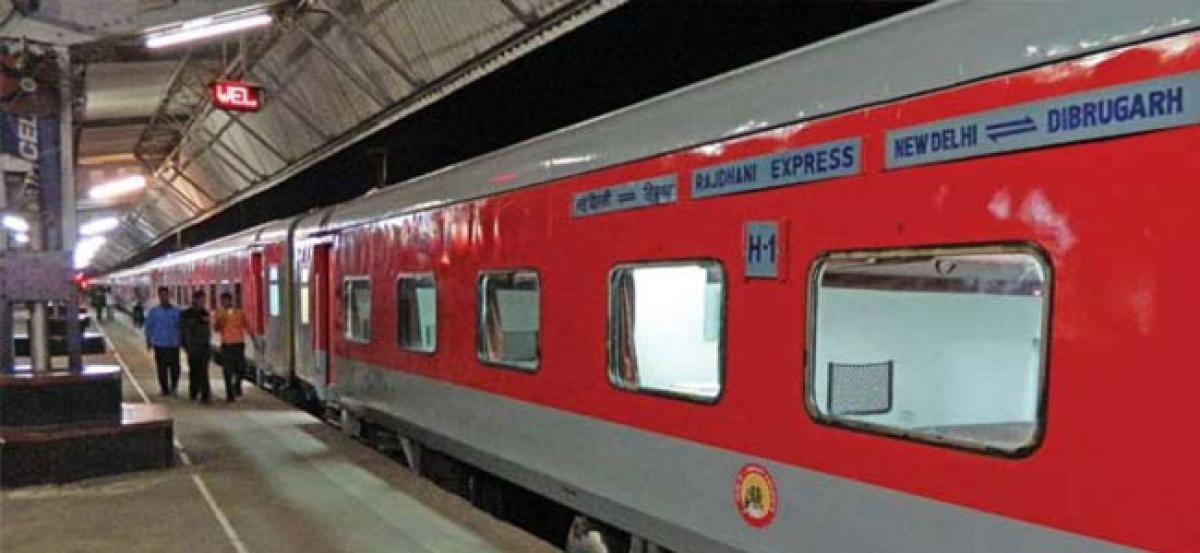Live
- Can a woman make such allegations out of imagination: K'taka Minister
- SA will shine through in Champions Trophy, says Walter after 3-0 loss to Pakistan
- Trump Demands Panama Canal Return, Criticises Panama's Management and Fees
- PV Sindhu Marries Venkata Datta Sai in a Grand Ceremony in Udaipur
- Not satisfied, I want more: De Minaur sets sights on plenty of goals in 2025
- Upset over exclusion from cabinet, Bhujbal meets CM Fadnavis over 'growing' OBC resentment
- Australia prepares for catastrophic bushfire over Christmas period
- Global prevalence of atopic dermatitis to reach 42.42 mn by 2033: Report
- OpenAI's GPT 5 Faces Delays Amid Data and Financial Challenges
- Sunny Leone's Name Used in Fraud Under Chhattisgarh’s Mahtari Vandan Yojana
Just In

In a strong rebuke to the railways flexifare system, the CAG has warned the scheme could force passengers to opt for airlines, noting that the national transporter had already lost its premium train patronage to other mail and express trains
In a strong rebuke to the railways' flexi-fare system, the CAG has warned the scheme could "force" passengers to opt for airlines, noting that the national transporter had already lost its premium train patronage to other mail and express trains.
The Comptroller and Auditor General of India (CAG) in its report for year ending March 2017, has stated that while the introduction of the flexi-fare system in premium trains -- Rajdhani, Shatabdi and Duronto -- has led to increase in passenger earnings in this category of trains to Rs 552 crore, they have carried 6.75 lakh fewer travellers during September 9, 2016 to July 31, 2017, compared to the corresponding period in 2015-2016.
"Wherever dynamic/enhanced fare was introduced, the occupancy was very low. However, this aspect was not taken into consideration while introducing the flexi fare system in all Rajdhani, Duronto and Shatabdi trains irrespective of demand and occupancy.
"Even in AC 3 class, which was one of the most profitable classes, the occupancy dropped significantly after the introduction of flexi fare and the vacant berths increased from 0.66 per cent in pre-flexi period to 4.46 per cent in post-flexi period," the report stated.
In terms of absolute numbers, the premier trains carried 2.40 crore passengers during post-flexi period (September 9, 2016 to July 31, 2017) as compared to 2.47 crore passengers during pre-flexi period (September 9, 2015 to July 31, 2016), said the CAG in its report.
"The occupancy of mail and express trains in the routes of premium trains run was found to be much more than the premium trains during the months test checked (October 2016 and February 2017). As such, passengers preferred to travel by mail and express trains over Rajdhani, Shatabdi and Duronto trains despite a higher travel time," the auditor said.
It also stated that a comparison with air fare for 13 sectors showed that travelling in aeroplane was cheaper than in train for a large number of routes.
When compared to the cost and time taken for travel by premium trains, air fare became a cheaper and preferable mode of travel, the auditor said.
"While in air fares the prices of tickets increase with increase in demand, in flexi fare, there is a fixed increase in fares after every 10 per cent of the tickets booked irrespective of the demand. By paying a higher price for an air ticket, a passenger is ensured a confirmed seat, but a passenger who purchases a waitlisted train ticket by paying a higher amount does not have an assurance of confirmed ticket.
"Thus, charging a higher fare without providing confirmed seat/berth would force passengers to explore other available alternatives," the report stated.
The CAG also conducted a survey among 806 passengers in 16 Shatabdi and 11 Rajdhani trains during April and May 2017. To the question Given the travel time, flexi fare without value addition, would you prefer to travel by flight/bus', 497 passengers (62 per cent) replied in affirmative, the CAG found.
Even after introduction of flexi-fare, punctuality of trains has not been maintained, it observed.
The proposal to introduce flexi fare structure in Rajdhani, Duronto and Shatabdi trains was mooted in August 2016 by the Railway Board in order to achieve the additional revenue generation of Rs 5,800 crore in the passenger earnings.
The Rajdhani, Duronto and Shatabdi trains running in most sectors were highly popular with high average occupancy and contributed about 12 per cent of total Passenger Reservation System (PRS) earnings, the CAG stated, questioning the judiciousness of the decision to introduce the system, which can lead up to 50 per cent increase in the base fare.
The CAG said that the national transporter needs to review the scheme so that not only revenue but also the number of passengers increase.
"There is a need for review and fine-tuning in the scope of the scheme so that not only more revenue is earned but a number of passengers also increase, thus, further enhancing revenue," said the report.
The railway board in its reply to CAG has stated that a committee has already reviewed the scheme and submitted its report in January 2018 and their recommendations are under the consideration of the ministry.

© 2024 Hyderabad Media House Limited/The Hans India. All rights reserved. Powered by hocalwire.com







